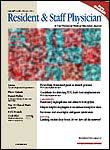Publication
Article
Resident & Staff Physician®
Study Examines Factors in the Development of HIV-Controlling Antibodies
Author(s):
The study identified several characteristics to observe in HIV patients who develop broadly neutralizing HIV antibodies (bnAbs), which occur naturally in about one percent of those infected with the disease and could be key in an eventual vaccine. Black patients were found more likely to develop them than white.
Published in Nature Medicine¸ a Swiss study provides further insight into the development of naturally-occurring antibodies that can fight the human immunodeficiency virus (HIV), and opens new avenues for research. The antibodies could play a role in the eventual creation of an HIV vaccine.
Broadly neutralizing HIV antibodies (bnAbs) can mute HIV by binding to the “spikes” on the surface of the virus. Their greatest asset may be their ability to attack not just the specific strain of HIV in the individual’s body, but due to the uniformity of those sugar and protein “spikes”, bnAbs can be deployed against many of the different HIV strains that circulate around the world.
Out of nearly 4,500 patient records reviewed from the Swiss HIV Cohort Study and the Zurich Primary HIV Infection Study, 239 were identified to have formed the antibodies. In general, about one percent of HIV-positive people develop them during their lifetime.
The researchers were able to identify three characteristics involved in bnAb development: virus load, or the number of viruses in the body; the diversity of virus types in the body; and the duration that the patient had been infected with such viruses. Notably, these factors can be examined independently of one another.
In a press release that accompanied the study, Huldrych Günthard, one of the authors, stressed underlined why the independence of the factors mattered: “So we don’t necessarily have to consider all three parameters in designing an HIV vaccine. This is especially important with regard to the length of vaccine administration — it wouldn’t be possible to imitate a longer untreated HIV infection with a vaccine.”
In addition to these characteristics, the team identified other major factors in a patient’s development of bnAbs. One was the particular subtype of the HIV infection: subtype B HIV infections and non-subtype B caused the formation of different antibodies, which bound to the virus at different sites. Varying structural features of the virus influence the formation of antibodies to fight it.
Another finding of interest was that black patients were significantly more likely to develop bnAbs than white patients, creating an interesting bridge to further research, encouraging future studies that consider what role genetic and socioeconomic forces play in the development of these important disease-fighting antibodies.
